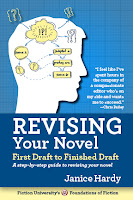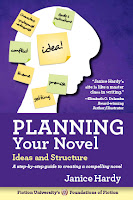Everyone’s writing process is different, but there are similarities—which is why writers are able to help each other even though we approach our writing in various ways. For some, first drafts are easy, and the hard part comes from knowing where to go from there.
Sometimes the issue is simply not knowing how to start a revision, but sometimes a writer will find they’re just too close to the work and can’t see what’s on the page versus what they know about the story.
For those with great memories who have trouble not seeing what it’s supposed to say, it can be hard to spot weak area and places that need editing. These writers might try taking a slightly different approach.
(Here’s more on a first look at a first draft)
Get Some Distance on a First Draft
Though it might not work for every writer facing this challenge, the first step is to get some distance and let the manuscript sit for a while, even if that takes a month or two (or more). You want to give yourself time to forget the details, so when you revisit the draft you can better see what’s actually there instead of what you meant to write.
(Here’s more on getting what’s in your head onto the page)
Find Outside Help
If you’re a writer who remembers your stories far too well, a few solid beta readers can be a lifesaving resource for you. Find critique partners who don’t know your story or anything about it beyond what they’d read on the cover copy had they bought this book in a store. Ask them to be ruthless and find all the plot holes, confusing areas, weak spots, and whatever they feel needs more fleshing out (or trimming back).
Beta readers can only see what’s on the page, so they can give you an objective view of how the draft reads. You can use their feedback to guide you in your revisions.
(Here’s more on questions to ask your beta readers and critique partners)
Distract Yourself With a New Project
If you have no access to beta readers, try putting that mighty memory to work on another project. Start work on the next book while the first draft sits, so when you return to it, your mind is filled more with the new project and you have a clearer head to see the original first draft as it is.
Use a Guide or Structure Template
Depending on what a first drafts needs, using a tried-and-true structure guide can help you double check if your draft is doing what it should or not. Some structures, such as the Three Act Structure, the Save the Cat Beat Sheet, or the Hero’s Journey, have specific turning points at specific times in a story you can use to gauge your draft.
(Here’s more on common story structures)
You could also try following a revision or story planning guide, such as (shameless plug, but this is why I wrote them) my Planning Your Novel: Ideas and Structure book, or my At-Home Revision Workshop on this site (the more-detailed revision guide will be out sometime this summer). These books are designed to ask lots of questions and lead you through the story and revision process, forcing you to look at your work more objectively. When you’re looking for something specific, it’s easier to tell if you have it or not.
(Here’s more on my At-Home Revision Workshop)
If judging your own work is hard for you, I highly suggest finding some good critique partners you can trade work with. A second (or third, or fourth) set of eyes is probably the easiest way to see what’s missing from a draft you’re too close to.
If you have difficulty finding partners, try joining my Critique Connection to find like-minded writers. I open it up to new members twice a year, on January 1 and July 1, but anyone can join at any time. It’s just more active during those months.
Do you have trouble getting past the first draft? What advice would you give someone struggling with this problem?
 Looking for tips on revising your novel? Check out my book Revising Your Novel: First Draft to Finished Draft,
a series of self-guided workshops that help you revise your manuscript
into a finished novel. Still working on your idea? Then try my
just-released Planning Your Novel Workbook.
Looking for tips on revising your novel? Check out my book Revising Your Novel: First Draft to Finished Draft,
a series of self-guided workshops that help you revise your manuscript
into a finished novel. Still working on your idea? Then try my
just-released Planning Your Novel Workbook.  A
long-time fantasy reader, Janice Hardy always wondered about the
darker side of healing. For her fantasy trilogy The Healing Wars, she
tapped into her own dark side to create a world where healing was
dangerous, and those with the best intentions often made the worst
choices. Her novels include The Shifter, Blue Fire, and Darkfall from Balzer+Bray/Harper Collins. The Shifter,
was chosen for the 2014 list of "Ten Books All Young Georgians Should
Read" from the Georgia Center for the Book. It was also shortlisted for
the Waterstones Children's Book Prize, and The Truman Award in 2011.
A
long-time fantasy reader, Janice Hardy always wondered about the
darker side of healing. For her fantasy trilogy The Healing Wars, she
tapped into her own dark side to create a world where healing was
dangerous, and those with the best intentions often made the worst
choices. Her novels include The Shifter, Blue Fire, and Darkfall from Balzer+Bray/Harper Collins. The Shifter,
was chosen for the 2014 list of "Ten Books All Young Georgians Should
Read" from the Georgia Center for the Book. It was also shortlisted for
the Waterstones Children's Book Prize, and The Truman Award in 2011.  Janice is also the founder of Fiction
University, a site dedicated to helping writers improve their craft.
Her popular Foundations of Fiction series includes Planning Your Novel: Ideas and Structure, a self-guided workshop for planning or revising a novel, the companion Planning Your Novel Workbook, Revising Your Novel: First Draft to Finished Draft, and the upcoming Understanding Show Don't Tell (And Really Getting It).
Janice is also the founder of Fiction
University, a site dedicated to helping writers improve their craft.
Her popular Foundations of Fiction series includes Planning Your Novel: Ideas and Structure, a self-guided workshop for planning or revising a novel, the companion Planning Your Novel Workbook, Revising Your Novel: First Draft to Finished Draft, and the upcoming Understanding Show Don't Tell (And Really Getting It). Website | Facebook | Twitter | Goodreads | Amazon | Barnes & Noble | iTunes | Indie Bound


As usual, another good post. I have used a combination of Save the Cat and the Three Act Story Structure and it was very helpful.
ReplyDeleteThanks!
Delete